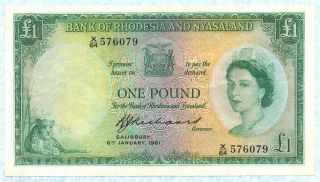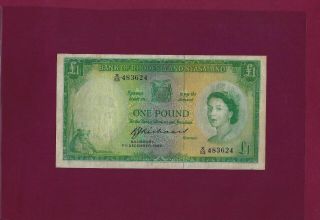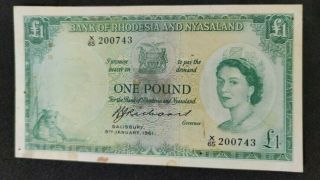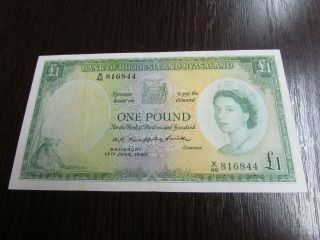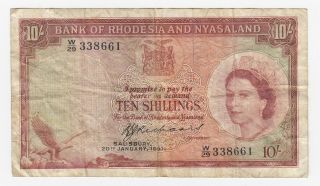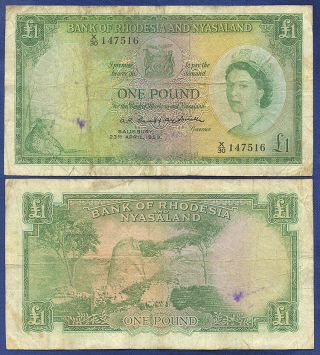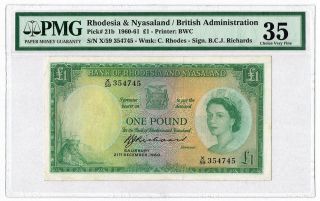Rhodesia And Nyasaland 1 Pound 1961 P - 21b (tear) G
Item History & Price
| Reference Number: Avaluer:22759017 | Country: Rhodesia and Nyasaland |
| Year: 1961 | Type: Banknotes |
| Circulated/Uncirculated: Circulated |
One banknote of Rhodesia and Nyasaland 1 Pound 1961 P-21b (signature J.Richards) .Condition (opinion):Good (G) .Tears or Cuts: two at upper edge (one large of 16mm at upper central fold and other of 2mm art upper left) .See scan.Size:14, 8cm/8, 1cm (average) Printer:Bradbury Wilkinson & Co.Ltd.-----------------------------------------------------------------------------Postage, including packing material, handling fees : Europe: USD 4.10 / US...A $4.90. Rest of the World:USD 5.30 FREE of postage for any other additional banknote or stocks & bonds .From the shop , post charges are only for the first item purchased or only , one time , the highestpost charges if several different items purchased throughout the store.Guaranteed genuine. - One month return policy for the banknotes (retail sales).When there is more than one banknote for sale the serial number may differ from that shown in the picture.Customers are invited to combine purchases to save postage.
Full refund policy , including shipping cost, guaranteed in case of lost or theft after the completion of the complaint with Spanish Correos for the registered letters (normally purchases above $ 40.00).------------------------------------------------------------------------------Banknote GradingUNCAUEFVFFVGGFairPoorUncirculatedAbout UncirculatedExtremely FineVery FineFineVery GoodGoodFairPoorEdgesno counting markslight counting folds OR...light counting foldscorners are not fully roundedmuch handling on edgesrounded edgesFoldsno folds...OR one light fold through centermax. three light folds or one strong creaseseveral horizontal and vertical foldsmany folds and creasesPapercolorpaper is clean with bright colorspaper may have minimal dirt or some color smudging, but still crisppaper is not excessively dirty, but may have some softnesspaper may be dirty, discolored or stainedvery dirty, discolored and with some writingvery dirty, discolorated, with writing and some obscured portionsvery dirty, discolored, with writing and obscured portionsTearsno tearsno tears into the borderminor tears in the border, but out of designtears into the designHolesno holesno center hole, but staple hole usualcenter hole and staple holeIntegrityno pieces missingno large pieces missingpiece missingpiece missing or tape holding pieces together
See below for related information from the web:The Federation of Rhodesia and Nyasaland, also known as the Central African Federation (CAF), was a semi-independentfederation of three southern African territories – the self-governing British colony of Southern Rhodesia and the British protectorates of Northern Rhodesia and Nyasaland – between 1953 and 1963.The Federation was established on 1 August 1953.[1][2] The Federation was established with a Governor-General as the Queen's Representative at the centre. An interesting and novel feature was the African Affairs Board, set up to safeguard the interests of Africans and endowed with statutory powers for that purpose, particularly in regard to discriminatory legislation.[3] The constitutional status of the three territories - a self-governing Colony and two Protectorates- was not affected, though certain enactments applied to the Federation as a whole as if it were part of Her Majesty's dominions and a Colony.[4] The economic advantages to the Federation were never seriously called into question and the causes of the Federation's failure were purely political: the strong and growing oppositing of the African inhabitants.[5]
The rulers of the new black African states were united in wanting to end colonialism in Africa. With most of the world moving away from colonialism during the late 1950s and early 1960s, the United Kingdom was subjected to pressure to de-colonize from both the United Nations and the Organization of African Unity (OAU). These groups supported the aspirations of the black African nationalists and accepted their claims to speak on behalf of the people.
The federation officially ended on 31 December 1963.[6][7] In 1964, shortly after the dissolution, Northern Rhodesia became an independent republic under the name Zambia and Nyasaland became the independent commonwealth realm of Malawi. In 1965, Southern Rhodesia broke with United Kingdom law and unilaterally declared itself independent under the name Rhodesia.
Constitutional origins[edit]It was commonly understood that Southern Rhodesia would be the dominant territory in the federation – economically, electorally, and militarily. How much so defined much of the lengthy constitutional negotiations and modifications that followed. African political opposition and nationalist aspirations, for the time, were mute.
Decisive factors in both the creation and dissolution of the Federation were the significant difference between the number of Africans and Europeans in the Federation, and the difference between the number of Europeans in Southern Rhodesia compared to the Northern Protectorates. Compounding this was the significant growth in Southern Rhodesia's European settler population (overwhelmingly British migrants), unlike in the Northern Protectorates. This was to greatly shape future developments in the Federation. In 1939, approximately 60, 000 Europeans resided in Southern Rhodesia; shortly before the Federation was established there were 135, 000; by the time the Federation was dissolved they had reached 223, 000 (though newcomers could only vote after three years of residency). Nyasaland showed the least European and greatest African population growth.
------------------------------------------------------------- Federation of Rhodesia and Nyasaland, also called Central African Federation, political unit created in 1953 and ended on Dec. 31, 1963, that embraced the British settler-dominated colony of Southern Rhodesia (Zimbabwe) and the territories of Northern Rhodesia (Zambia) and Nyasaland (Malaŵi), which were under the control of the British Colonial Office.From the 1920s white European settlers in the Rhodesias had sought some form of amalgamation to counter the overwhelming numerical superiority of black Africans, but this had been blocked by a British Colonial Office that was sensitive to profound African opposition. After World War II the growth of secondary industries ... (100 of 346 words)
00161
Full refund policy , including shipping cost, guaranteed in case of lost or theft after the completion of the complaint with Spanish Correos for the registered letters (normally purchases above $ 40.00).------------------------------------------------------------------------------Banknote GradingUNCAUEFVFFVGGFairPoorUncirculatedAbout UncirculatedExtremely FineVery FineFineVery GoodGoodFairPoorEdgesno counting markslight counting folds OR...light counting foldscorners are not fully roundedmuch handling on edgesrounded edgesFoldsno folds...OR one light fold through centermax. three light folds or one strong creaseseveral horizontal and vertical foldsmany folds and creasesPapercolorpaper is clean with bright colorspaper may have minimal dirt or some color smudging, but still crisppaper is not excessively dirty, but may have some softnesspaper may be dirty, discolored or stainedvery dirty, discolored and with some writingvery dirty, discolorated, with writing and some obscured portionsvery dirty, discolored, with writing and obscured portionsTearsno tearsno tears into the borderminor tears in the border, but out of designtears into the designHolesno holesno center hole, but staple hole usualcenter hole and staple holeIntegrityno pieces missingno large pieces missingpiece missingpiece missing or tape holding pieces together
See below for related information from the web:The Federation of Rhodesia and Nyasaland, also known as the Central African Federation (CAF), was a semi-independentfederation of three southern African territories – the self-governing British colony of Southern Rhodesia and the British protectorates of Northern Rhodesia and Nyasaland – between 1953 and 1963.The Federation was established on 1 August 1953.[1][2] The Federation was established with a Governor-General as the Queen's Representative at the centre. An interesting and novel feature was the African Affairs Board, set up to safeguard the interests of Africans and endowed with statutory powers for that purpose, particularly in regard to discriminatory legislation.[3] The constitutional status of the three territories - a self-governing Colony and two Protectorates- was not affected, though certain enactments applied to the Federation as a whole as if it were part of Her Majesty's dominions and a Colony.[4] The economic advantages to the Federation were never seriously called into question and the causes of the Federation's failure were purely political: the strong and growing oppositing of the African inhabitants.[5]
The rulers of the new black African states were united in wanting to end colonialism in Africa. With most of the world moving away from colonialism during the late 1950s and early 1960s, the United Kingdom was subjected to pressure to de-colonize from both the United Nations and the Organization of African Unity (OAU). These groups supported the aspirations of the black African nationalists and accepted their claims to speak on behalf of the people.
The federation officially ended on 31 December 1963.[6][7] In 1964, shortly after the dissolution, Northern Rhodesia became an independent republic under the name Zambia and Nyasaland became the independent commonwealth realm of Malawi. In 1965, Southern Rhodesia broke with United Kingdom law and unilaterally declared itself independent under the name Rhodesia.
Constitutional origins[edit]It was commonly understood that Southern Rhodesia would be the dominant territory in the federation – economically, electorally, and militarily. How much so defined much of the lengthy constitutional negotiations and modifications that followed. African political opposition and nationalist aspirations, for the time, were mute.
Decisive factors in both the creation and dissolution of the Federation were the significant difference between the number of Africans and Europeans in the Federation, and the difference between the number of Europeans in Southern Rhodesia compared to the Northern Protectorates. Compounding this was the significant growth in Southern Rhodesia's European settler population (overwhelmingly British migrants), unlike in the Northern Protectorates. This was to greatly shape future developments in the Federation. In 1939, approximately 60, 000 Europeans resided in Southern Rhodesia; shortly before the Federation was established there were 135, 000; by the time the Federation was dissolved they had reached 223, 000 (though newcomers could only vote after three years of residency). Nyasaland showed the least European and greatest African population growth.
------------------------------------------------------------- Federation of Rhodesia and Nyasaland, also called Central African Federation, political unit created in 1953 and ended on Dec. 31, 1963, that embraced the British settler-dominated colony of Southern Rhodesia (Zimbabwe) and the territories of Northern Rhodesia (Zambia) and Nyasaland (Malaŵi), which were under the control of the British Colonial Office.From the 1920s white European settlers in the Rhodesias had sought some form of amalgamation to counter the overwhelming numerical superiority of black Africans, but this had been blocked by a British Colonial Office that was sensitive to profound African opposition. After World War II the growth of secondary industries ... (100 of 346 words)
00161



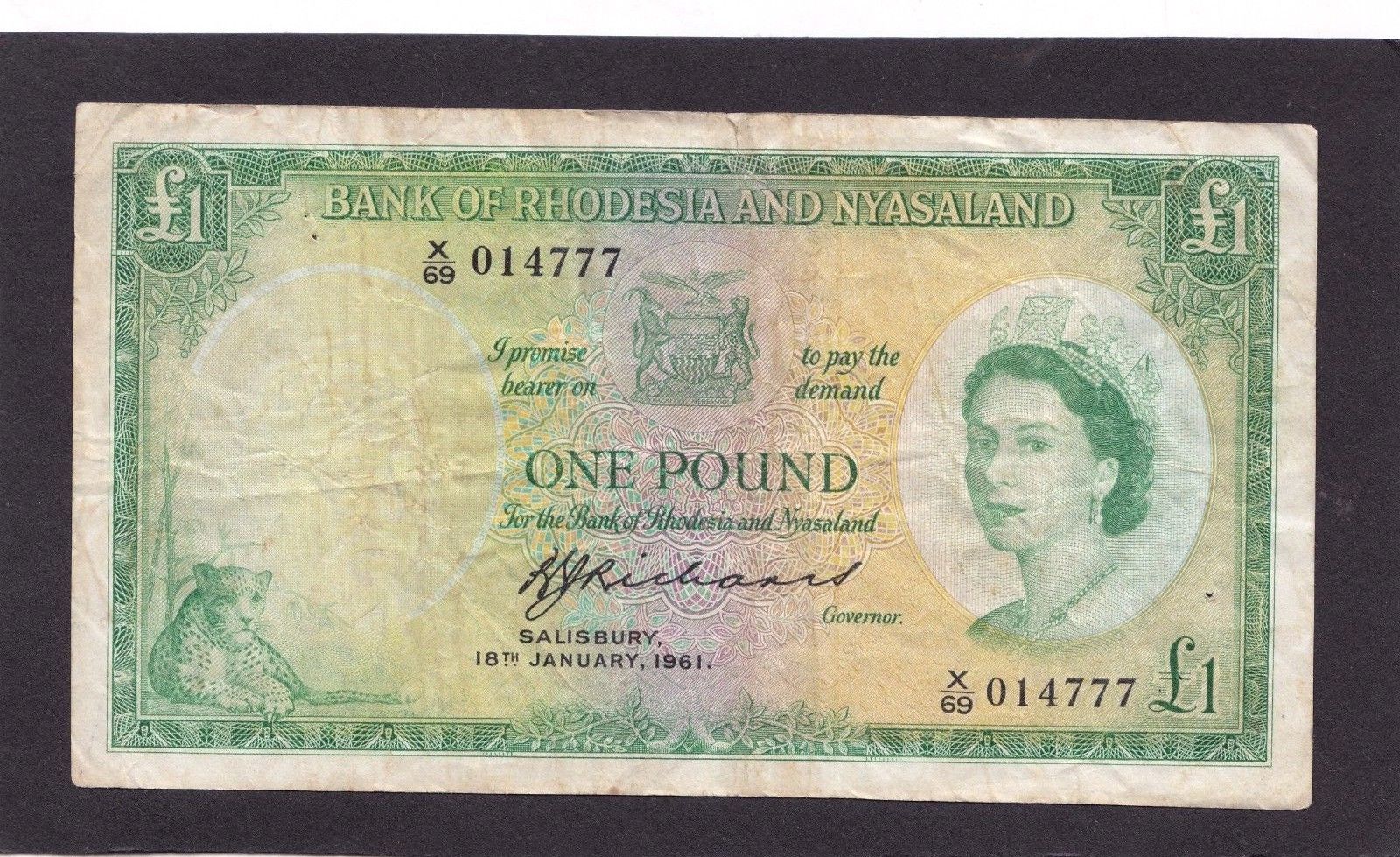
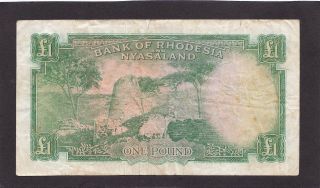
![[ 576368] Banknote, Rhodesia And Nyasaland, 1 Pound, 1961, 1961 - 01 - 04, Km:21b](https://pic-l.avaluer.net/imgstmb/e/n/i/g/p/-_576368_banknote__rhodesia_and_nyasaland__1_pound__1961__1961___01___04__km21b-1_21000_tmb.jpg)
